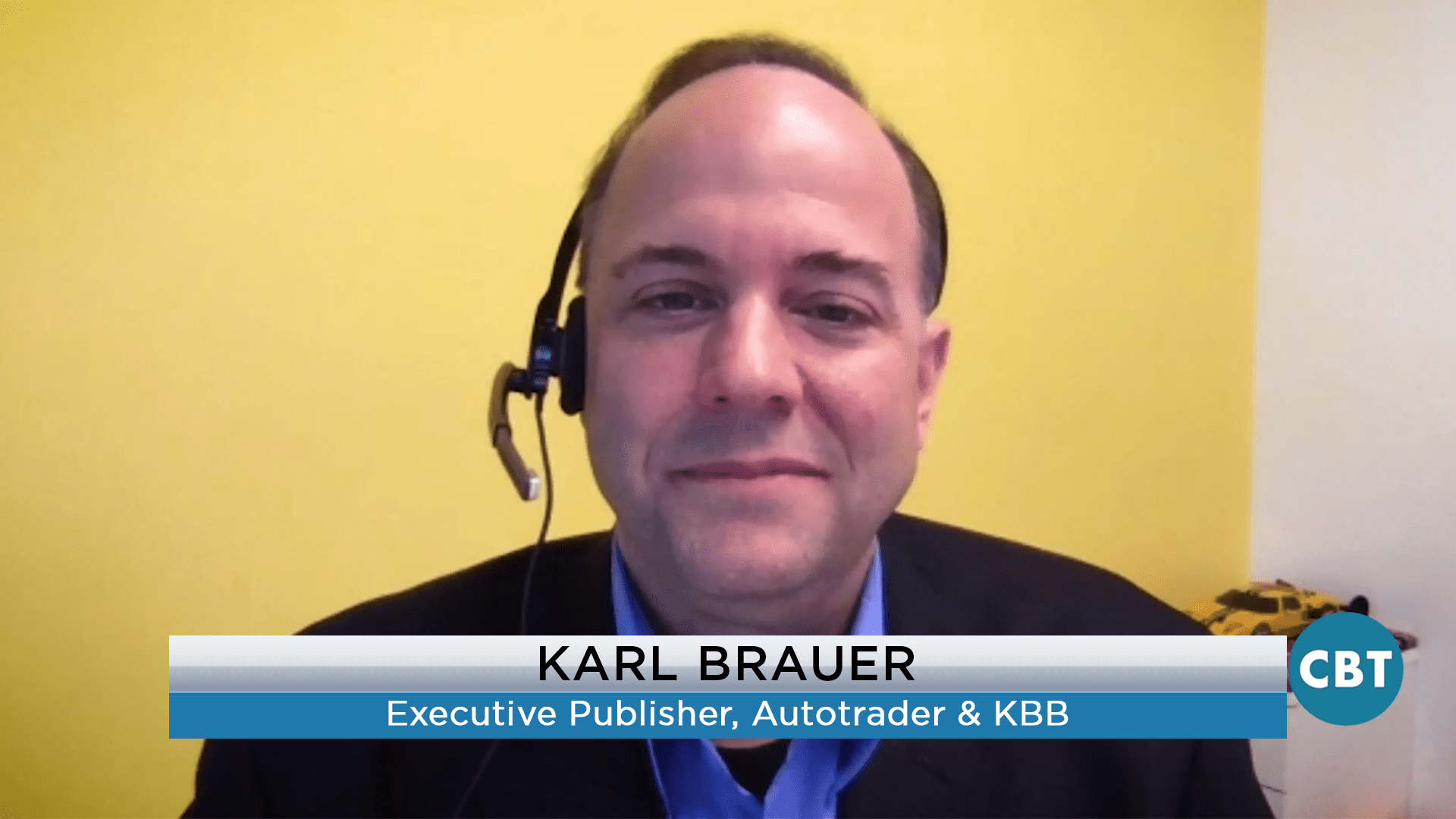The first quarter of the fiscal year is officially over, and there are a lot of numbers and trends to break down. Here to talk to us more about March’s earnings is Karl Brauer, executive publisher for AutoTrader and Kelley Blue Book. Karl shares with us, his insight about this month’s winners, losers, the importance of CPO vehicles, and what dealers can expect as we head into Q2.
Jim Fitzpatrick: Karl Brauer, thank you so much for taking the time out of your busy schedule to join us on CBT News.
Karl Brauer: Absolutely, Jim. Great being on with you.
Jim Fitzpatrick: Sure. Let’s talk about March. What are some of the winners and losers out there?
Karl Brauer: Sadly, we’ve got a few more losers than we do winners. We had some people bucking the trend, like Honda, and Volkswagen, and Mitsubishi, and of course, Tesla is always a wildcard. But all the biggies, the big domestics, Nissan, Toyota, they were down both in March and for the quarter. Right now, we’re looking at the first potential year where we might not hit 17 million or more sales since 2014, given the start of the year.
Jim Fitzpatrick: So, what do you attribute the auto industry in somewhat a flux right now?
Karl Brauer: Jim, there’s a lot going on. Obviously, you’ve got rising transaction prices, and that’s being driven largely by people moving to trucks and SUVs, which are almost always more expensive than an equivalent car size. But then you have high interest rates, so it’s a bad double-whammy when you’ve got the price of the vehicles going up and the price of borrowing the money to finance the vehicles going up simultaneously. That’s a double-whammy. It’s driven up the average price over $800, over 2.3% since a year ago, and it’s driven up the average payment 3.5% to $567 a month for your average new car payment.
This is driving a lot of people to reconsider new and maybe look at used, which is still down around 414. $150 a month, that’s real money. Over 12 months, and over a three, five, six-year loan, that’s real money.
Jim Fitzpatrick: Right, yep. And probably even people holding on to their cars longer, too. You throw that in there as well. People look at their vehicles, and … Because cars are lasting longer, they’ve got the technology built-in, and they say, “What’s my real motivation to go the extra mile on my cost each month?” And that’s a concern, right?
Karl Brauer: That’s exactly what drove the sales down in the recession, back in ’09 and ’10, is people just hung on to their cars and the cars got much older … The average age of the car on the road got much older, and I think … Exactly what you said, Jim. It opened a lot of people’s eyes to the idea that “Wait a second, I don’t gotta switch every three years, or even every five years. These cars will go for years and years and years.” And so, I think people are more aware of that, and they’re more willing to hold off if there’s other factors like interest rates and transaction prices that are driving.
Jim Fitzpatrick: Sure. And even socially, it’s okay now to pull up at the country club with a eight or nine year old vehicle that still looks good, rather than, “Hey, that’s the same vehicle you’ve been driving for the last 24 months, how dare you.” Or-
Karl Brauer: Exactly.
Jim Fitzpatrick: You know what I mean?
Karl Brauer: No, I mean … That was what was interesting about the recession, was that I think it actually almost became something to not be proud of if you had a brand new car.
Jim Fitzpatrick: Yeah, good point.
Karl Brauer: Because people were suffering so much that if you were driving around a brand new luxury car … I know a lot of business owners back then who personally could’ve rotated to a new vehicle, and they didn’t for just that reason.
Jim Fitzpatrick: Yes. That’s exactly right. That’s exactly right. What kinda stands out in March’s data reports for new and used vehicle sales?
Karl Brauer: It’s fascinating to watch some of the big battles going on. I think probably the most interesting one is the full-size truck battle. These are huge, high-profit vehicles, and their sales are still doing relatively well because I think they’re less price-sensitive. What we’re seeing is that non-price sensitive categories, big SUVs, big trucks, luxury vehicles, surprise surprise, they’re not being as impacted by rising interest rates and rising transaction prices.
So, there’s a lot of profit built in to those vehicles. Of course, the F-150, the Silverado, and the Ram, those are huge profit drivers for the domestics. And they all want to sell those vehicles at all times, and you’re seeing Ram, so far this year, beating Silverado in sales.
Jim Fitzpatrick: Let’s talk about Q1. Q1’s officially ended, obviously. What do the numbers for the whole quarter look like?
Karl Brauer: They’re down around 3% for the quarter. That’s targeting, or tracking, at a SAAR of around 16-eight, which is … Not to make a big point of it, but that’s exactly what we predicted … The Cox Automotive prediction for 2019 is 16-eight. So, so far, our prediction’s fairly accurate. Unfortunately, they’re living up to our number, whether we want them to or not. That’s where we’re at right now, and again, we’re tracking to a non-17 million year SAAR. Now, I personally think we could still see a shift. The last two years, both years started out weak and the second half really brought things around.
A lot of people are like, “Well, there was a tax refund, there were other things,” and all. This year, we’ve got this China issue. If it goes the wrong way, or if it goes bad in terms of tariffs, we could see a much lower than 16-eight million new car sales. If, all of a sudden, prices are going up by a 25% tariff on all imports and all the supplies and all the parts that come in … Flip side is, if the governments between China and the US work out a deal and there isn’t a big tariff issue, I think that’ll bolster economic sentiment across the country, and it certainly will not raise vehicle prices. And we could see a whipsaw effect the other way, and we could see sales strengthen and maybe we do hit 17 million this year. So that, to me, is the biggest variable, is the China tariff issue.
Jim Fitzpatrick: Dealers out there could realize an increase in sales on the used car side. In fact, it’s almost probable in a good economy, right?
Karl Brauer: Exactly right, Jim. Not just an increase in sales, but of sales of cars that are higher-profit, like you said. That’s incredibly important, and it’s funny you mention that because that’s another factor playing into the new car sales, which is basically a lack of incentives. Both the manufacturers and the dealers are not working hard to push these cars out, because they’ve kept their inventories more in check than in previous years when it started to slow down. They kind of … I think they really learned on the recession 10 years ago, and so they’ve been much more careful about flexible manufacturing and, as a result, not only do you have higher transaction prices and higher interest rates, but you don’t have as much incentive activity going on to push these cars out the door. It’s just the reasons you’ve said. I think both the dealers, for sure, and even some manufacturers.
I think General Motors has made it very clear for the last couple years under Mary Barra that they’re not gonna chase volume. They’re gonna chase smart business practices, which starts with profitability, and I think you see that. The fact that they’re not incentivizing the Silverado to try to keep up with Ram, they’re fine letting the Ram have a higher volume. They’re feeling like they’re getting more profit per vehicle.
Jim Fitzpatrick: The notion that … Where we continue … We’re so focused in this industry on the SAAR, it’s unbelievable, isn’t it? We just … Is it gonna be 16-eight, is it gonna drop to 16, is it gonna be 17-2? My whole life as a dealer depends on that SAAR, when at the end of the day, I might sell … I might make that up and then some out of my used car department.
Karl Brauer: And I think now you’re talking about something else we were both seeing go on, which is they’re starting to pull away from monthly sales reporting, right?
Jim Fitzpatrick: That’s right.
Karl Brauer: We’ve already seen GM and Ford jump out, and I’ve heard from a couple other manufacturers off the record that they’re gonna do that too.
Jim Fitzpatrick: Yeah. Wow, okay.
Karl Brauer: The idea that you live and die by each monthly sales number versus a larger trend line based on quarters, which is much more representative of where things are going-
Jim Fitzpatrick: That’s right. I forgot about my service department and collision center behind my dealership. What about that? What does that look like?
Karl Brauer: Right.
Jim Fitzpatrick: So, every … I think dealers are very nimble, and they can pivot quickly, so when all of a sudden something falls down on this side, they pick it up on that side. They’ll do the same in these times, even if it drops below 16-eight. Like we might all explode at 16-eight, right? It’s crazy.
Karl Brauer: Right. Yeah, ’cause that’s such a terrible number. Like you said, there’s a lot of used vehicles out there coming off lease. They can CPO these vehicles and give people a new vehicle experience, in terms of peace of mind and warranty coverage. They get better profit from those vehicles. I think the dealers are gonna, like you said, be just fine. They can flex and move things around as to what they prioritize and still make their numbers.
Jim Fitzpatrick: That’s exactly right. Well, Karl Brauer with Autotrader and Kelley Blue Book, the executive publisher of both. Thank you so much for joining us on CBT News. We very much appreciate it. I will see you right back here in another 30 days, to be going over March … April’s numbers, rather, right?
Karl Brauer: We’ll be in Q2. We’ll see what the indicators suggest at that point.
Jim Fitzpatrick: That’s right. The months are flying by already. Thanks so much. Appreciate it.
Karl Brauer: Great being on with you, Jim. Take care.
Jim Fitzpatrick: Okay. Thanks.
You’re watching the official news source of the retail automotive industry. This has been a JBF Business Media production.









